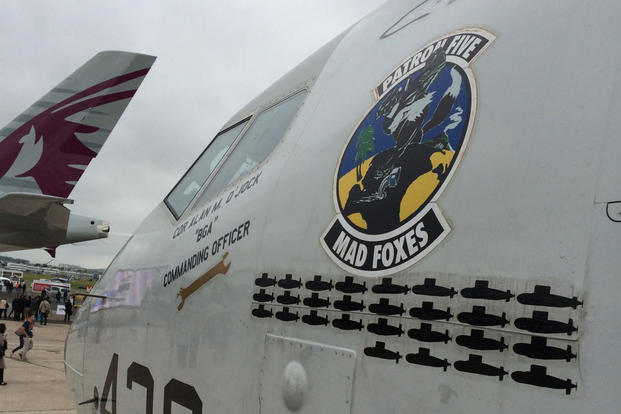PARIS -- Submarine-hunting aircraft don't typically get the kind of attention that the U.S. Navy's P-8 Poseidon has received at this year's Paris Air Show.
The P-8, built by Boeing Co., doesn't necessarily stand out on the flight line here at Le Bourget airport compared to some of the more exotic combat aircraft on display. Navy Lt. Cmdr. Adam Pace, a naval flight officer who's a tactical coordinator onboard a Poseidon, described the aircraft simply as a "militarized version of a 737" commercial airliner.
However, what sets the plane apart are the sensors, radios and sonobuoy launcher, as well as the working stations inside the aircraft, that allow sailors onboard to hunt submarines and surface warfare ships.
The aggressive actions of the Chinese and Russian navies have thrust the P-8 into the international spotlight, and the plane received a surge of attention here at the show. During recent deployments, the aircraft have tracked Chinese submarines.
And the Chinese have noticed. Last summer, a Chinese fighter jet intercepted a Poseidon over the South China Sea in international airspace and performed a barrel roll over it.
The P-8 on display here completed a seven-month deployment to the Pacific in February. Assigned to Patrol Squadron Five at Naval Air Station Jacksonville, Florida, the crew flew to Paris to show off the aircraft and teach the international community about it.
Pace could not offer many details about the unit's recent deployment, but he did highlight the 28 submarine decals painted on the side of the plane, each of which represented a foreign submarine identified and located by the squadron.
"You can take a look outside and see that it was a success with the submarine decals," he said as he provided a tour of the aircraft to Military.com reporters.
Navy leaders offered an inside peek of the P-8 to a national audience when it invited a CNN film crew to cover a mission a Poseidon flew over one of China's manmade islands in the South China Sea, which have raised tensions in the region.
Related Video
The decision to bring a film crew aboard startled some in the Navy. Pace acknowledged he was somewhat surprised by the move. But he also said part of their mission as P-8 crews is to "try to ensure that people around the world are aware of what's going on."
The P-8A was built to replace the P-3C as the Navy's long-range maritime patrol aircraft. The first aircraft was delivered in 2009. The U.S. Navy has six test aircraft and 26 operational planes located across the globe.
Overall, the service plans to buy 114 of the new P-8 aircraft at an estimated cost of $32.8 billion, according to Pentagon budget documents.
"As it's getting operationally deployed, we're learning more and more," Chris Raymond, a vice president at Boeing, said in an interview. Crews are coming back and describing its performance as a game-changer, he added, "so I think as the capability gets out there and starts being exercised, it's doing what it's supposed to do."
The Chicago-based aerospace giant also has contracts to deliver as many as a dozen of the aircraft to the governments of India and Australia, and is working to find more international customers.
"The international interest is developing," Raymond said. "Whether it's commercial threats, natural resource threats, regional security concerns, I do think this maritime space for a lot of people is going to become more and more important."
Pace, the flight officer who has about 1,500 hours on the P-3 and about 200 hours on the P-8, said the smoothness of the flight aboard the Poseidon compared to the Orion is immediately recognizable.
"On a P-3 with all the vibrations, the bumpiness, I felt like I went through 10 rounds with Ali," he said. On the P-8, "we don't feel like we're fighting our bodies as much as we're fighting the mission."
The aircraft carries an extensive sensor and radar suite to help the nine-person crew onboard find submarines and surface warfare ships. The sensor suite includes an active multi-static and passive acoustic sensor system, an electro-optical/infrared sensor and a digital magnetic anomaly detector. It also carries an inverse synthetic aperture radar.
The P-8 is better known for its intelligence, surveillance and reconnaissance abilities, but it also has four wing pylons and two centerline pylons to carry joint missiles, torpedoes and mines.
Boeing's P-8 is not the only maritime patrol aircraft receiving attention here at the air show. Kawasaki's P-1 is also popular among attendees. The P-1 is flown by Japan's Self Defense Force, and Kawasaki is trying to sell it to Britain to replace the Nimrod.
Pace said he sees similarities between the P-1 and P-8 with their similar mission set. He pointed out that the P-1 is a much larger aircraft.
"Whether the P-1's better, I can't speak to that," Pace said.
-- Michael Hoffman can be reached at Mike.Hoffman@military.com.
-- Brendan McGarry can be reached at Brendan.McGarry@military.com.




























